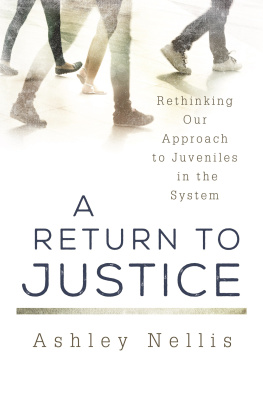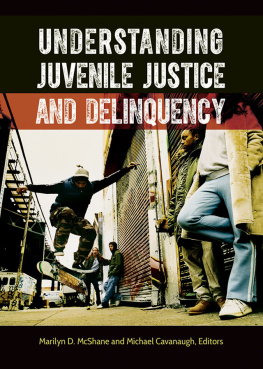Thank you for buying this ebook, published by NYU Press.
Sign up for our e-newsletters to receive information about forthcoming books, special discounts, and more!
Sign Up!
About NYU Press
A publisher of original scholarship since its founding in 1916, New York University Press Produces more than 100 new books each year, with a backlist of 3,000 titles in print. Working across the humanities and social sciences, NYU Press has award-winning lists in sociology, law, cultural and American studies, religion, American history, anthropology, politics, criminology, media and communication, literary studies, and psychology.
CHOOSING THE FUTURE
FOR AMERICAN JUVENILE JUSTICE
YOUTH, CRIME, AND JUSTICE SERIES
General Editors: Franklin E. Zimring and David S. Tanenhaus
Homeroom Security: School
Discipline in an Age of Fear
Aaron Kupchik
Kids, Cops, and Confessions: Inside
the Interrogation Room
Barry C. Feld
Choosing the Future for
American Juvenile Justice
Edited by Franklin E. Zimring
and David S. Tanenhaus
Choosing the Future for American Juvenile Justice
Edited by Franklin E. Zimring and David S. Tanenhaus
NEW YORK UNIVERSITY PRESS
New York and London
www.nyupress.org
2014 by New York University
All rights reserved
References to Internet websites (URLs) were accurate at the time of writing. Neither the author nor New York University Press is responsible for URLs that may have expired or changed since the manuscript was prepared.
Library of Congress Cataloging-in-Publication Data
Choosing the future for American juvenile justice / edited by Franklin E. Zimring and David S. Tanenhaus
pages cm. -- (Youth, crime, and justice series)
Includes bibliographical references and index.
ISBN 978-1-4798-1687-3 (hardback) ISBN 978-1-4798-3444-0 (paper)
1. Juvenile justice, Administration of--United States. 2. Juvenile delinquency--United States. I. Zimring, Franklin E. II. Tanenhaus, David Spinoza.
HV9104.C46 2014
364.360973--dc23
2013045560
New York University Press books are printed on acid-free paper, and their binding materials are chosen for strength and durability. We strive to use environmentally responsible suppliers and materials to the greatest extent possible in publishing our books.
Manufactured in the United States of America
10 9 8 7 6 5 4 3 2 1
Also available as an ebook
CONTENTS
Franklin E. Zimring and David S. Tanenhaus
Franklin E. Zimring
Franklin E. Zimring
Michael F. Caldwell
Aaron Kupchik
James Forman Jr.
David B. Thronson
James B. Jacobs
Franklin E. Zimring
Terry A. Maroney
Franklin E. Zimring and David S. Tanenhaus
ACKNOWLEDGMENTS
The idea for this volume was sparked by the anonymous reviewers who evaluated our proposal for the Youth, Crime, and Justice Series that this book now officially launches. Many people deserve our thanks for ensuring that a promising idea became a potentially useful book for those who care about children. These include our authors who presented drafts of their chapters in April 2013 at the Choosing the Future for Juvenile Justice Conference at the William S. Boyd School of Law at the University of Nevada, Las Vegas (UNLV); the session chairs and commentators (in order of appearance, Mary Berkheiser; James Forman Jr.; Ramona Denby Brinson; Anne Traum; Mximo Langer; Steve Wolfson, Clark County District Attorney; William Voy, Clark County Family Court Judge; John Valery White; Fatma Marouf; Michael Kagan; Ann Cammett; Donella Rowe, Deputy District Attorney Clark County; Jean Sternlight; Stacey Tovino; Rebecca Nathanson; and Catherine Cortez Masto, Nevada Attorney General); and the audience members who included juvenile justice practitioners and administrators from across the nation.
The Boyd School of Law and Berkeley Law provided essential and exemplary support for both the conference and this volume. UNLV Executive Vice President and Provost John Valery White nurtured the initial spark and Elaina Bhattacharyya, the Director of Strategic Initiatives at the Boyd School of Law, tended the flame. Elaina even found the contrasting images that now appear on the cover. As usual, Toni Mendicino of the Institute for Legal Research at Berkeley Law provided expert assistance in preparing this volume for publication. The Criminal Justice Research Program at Berkeley Law has supported the book series and its volumes since 2010.
Finally, we thank our dedicated editors at NYU Press, Ilene Kalish and Caelyn Cobb, for their stewardship of this project. This included securing timely and constructive evaluations of the entire manuscript by Barry Feld and other anonymous peer reviewers.
Introduction
FRANKLIN E. ZIMRING AND DAVID S. TANENHAUS
The juvenile court and the system of juvenile justice that it produced was invented in Illinois in 1899 and is now 115 years old. While it is the youngest of the major institutions of Anglo-American law, it has also become the most popular. There are juvenile courts in all 50 American states and in almost all the nations of the modern world.
But while the mission of the court is universally popular, the moving parts of juvenile justice in the United States have been changing almost from the beginning. The basic principles of the court in 2014 still reflect the intentions of its founders, but the priorities and power relations in juvenile justice have changed importantly in the past half-century.
Enduring Principles
The first enduring principle of the juvenile court was the radical idea that the law should treat children differently from adults. This radical idea is also an old one, predating the American Revolution. The political philosopher John Locke argued that childrens lack of reasoning capacity, which disqualified them from participating in government, also made them less culpable for their criminal acts. By the turn of the twentieth century, child advocates embedded the principle that children are different from adultsand thus require individualized handling of their casesinto the foundation of the worlds first juvenile courts. That bedrock assumption is still alive and well in 2014.
A second principle is closely and inextricably related to the first. Once juvenile courts were established, childrens advocates argued that childrens cases should be diverted from the destructive dynamics of the criminal justice system. This diversionary rationale made increasing sense in a society in which the modern ideal of a sheltered childhood became nearly universal by the middle decades of the twentieth century. For example, childrens advocates in Florida led a successful campaign in 1950 to amend the states constitution, so that the Florida could establish a separate justice system for juveniles based on the diversionary principle. Every American state has a commitment to juvenile courts, and this diversionary hegemony is secure for the foreseeable future.
Changing Procedures and Priorities
While the mission of the court for kids has remained popular, the informal structure and paternalist assumptions of the court were sharply curtailed by the US Supreme Court in




